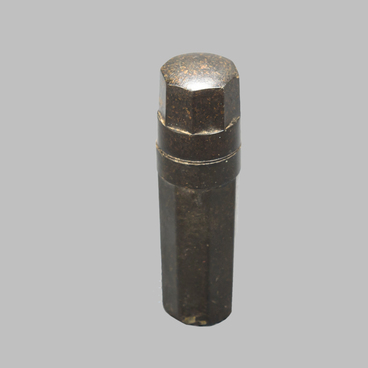The task to develop an aircraft-mounted 23mm autocannon was given to an experimental design bureau in Moscow OKB-16, which was headed by Yakov Grigoryevich Taubin. Simultaneously, Central Design Bureau No. 14 in Tula was also ordered to start developing a prototype. In the Bureau, three groups of designers were working on the gun on a competitive basis.
The VYa cannon, presented in the exhibition, was developed in 1940 in Central Design Bureau No. 14 by the designers Alexander Alexandrovich Volkov and Sergey Alexandrovich Yartsev. It was intended to engage protected ground targets specifically for the Il-2 attack aircraft which was being developed at the same time. Its prototype was called TKB-201. The Il aircraft was not ready, so the first field tests of the gun were carried out on a Messerschmitt Bf 110 fighter-bomber purchased in Germany. Tests on the Il-2 were carried out in 1941, after that the gun entered service with the Soviet Air Force under the designation VYa.
The VYa cannon was a fairly heavy (66 kg) and large (length — 2.15 m) gun. It was a gas-operated autocannon, that is, it used part of the force of expanding propellant gases to operate the action. The gun had a high rate of fire for its caliber (9–11 rounds per second) and accelerated a projectile weighing 200 grams (10 grams of explosive and 6 grams of incendiary charges) to a speed of 900 m/s. The high speed ensured a significant effective range. The ammunition of the gun consisted of 150 rounds. The disadvantages of the gun include a strong recoil and a very harsh recharging process, which reduced the service life of the gun and often caused problems.
The VYa guns were fitted symmetrically on the wings of the Il-2 attack aircraft. Fragmentation and fragmentation tracer rounds were quite effective against enemy infantry and light armored vehicles. Armor-piercing incendiary rounds of the cannon could penetrate 25-millimeter-thick armor at a distance of 400 meters. This made it possible to use the VYa guns to fight light tanks, and it could also penetrate the outer armor of medium tanks. However, in reality, this gun was quite difficult to operate. The Il-2 was controlled by one pilot, therefore it was inconvenient to aim at the same time. There also was another difficulty: when diving at an angle of 10–20 degrees, the shells almost always ricocheted. When diving at higher angles, the projectiles did not ricochet, but at a very low altitude, the pilot had only a few seconds at his disposal, during which it was necessary to aim, open fire and start climbing, which required an exceptionally high skill. Nevertheless, the cannon greatly increased the effectiveness of Soviet aviation in fighting enemy armored vehicles. In total, 64,655 guns were manufactured.
The VYa cannon, presented in the exhibition, was developed in 1940 in Central Design Bureau No. 14 by the designers Alexander Alexandrovich Volkov and Sergey Alexandrovich Yartsev. It was intended to engage protected ground targets specifically for the Il-2 attack aircraft which was being developed at the same time. Its prototype was called TKB-201. The Il aircraft was not ready, so the first field tests of the gun were carried out on a Messerschmitt Bf 110 fighter-bomber purchased in Germany. Tests on the Il-2 were carried out in 1941, after that the gun entered service with the Soviet Air Force under the designation VYa.
The VYa cannon was a fairly heavy (66 kg) and large (length — 2.15 m) gun. It was a gas-operated autocannon, that is, it used part of the force of expanding propellant gases to operate the action. The gun had a high rate of fire for its caliber (9–11 rounds per second) and accelerated a projectile weighing 200 grams (10 grams of explosive and 6 grams of incendiary charges) to a speed of 900 m/s. The high speed ensured a significant effective range. The ammunition of the gun consisted of 150 rounds. The disadvantages of the gun include a strong recoil and a very harsh recharging process, which reduced the service life of the gun and often caused problems.
The VYa guns were fitted symmetrically on the wings of the Il-2 attack aircraft. Fragmentation and fragmentation tracer rounds were quite effective against enemy infantry and light armored vehicles. Armor-piercing incendiary rounds of the cannon could penetrate 25-millimeter-thick armor at a distance of 400 meters. This made it possible to use the VYa guns to fight light tanks, and it could also penetrate the outer armor of medium tanks. However, in reality, this gun was quite difficult to operate. The Il-2 was controlled by one pilot, therefore it was inconvenient to aim at the same time. There also was another difficulty: when diving at an angle of 10–20 degrees, the shells almost always ricocheted. When diving at higher angles, the projectiles did not ricochet, but at a very low altitude, the pilot had only a few seconds at his disposal, during which it was necessary to aim, open fire and start climbing, which required an exceptionally high skill. Nevertheless, the cannon greatly increased the effectiveness of Soviet aviation in fighting enemy armored vehicles. In total, 64,655 guns were manufactured.




